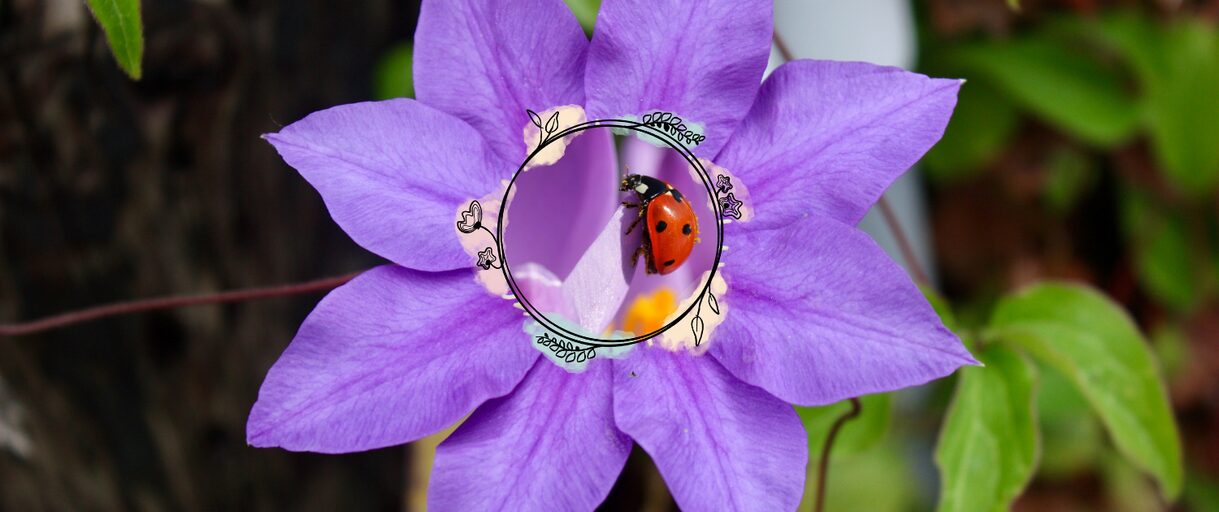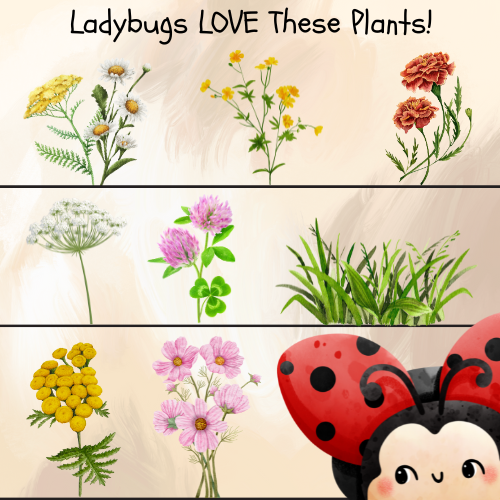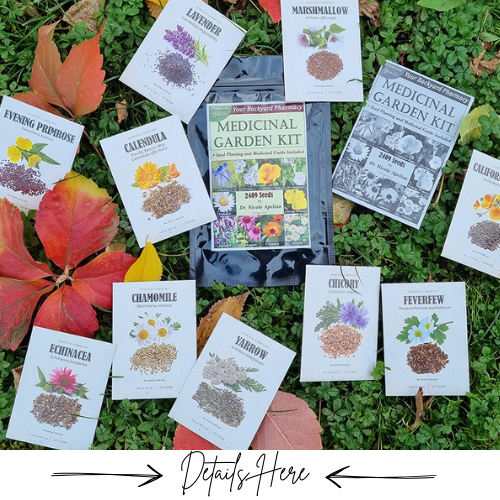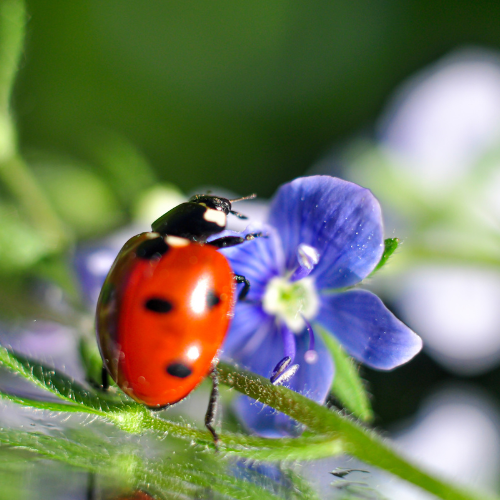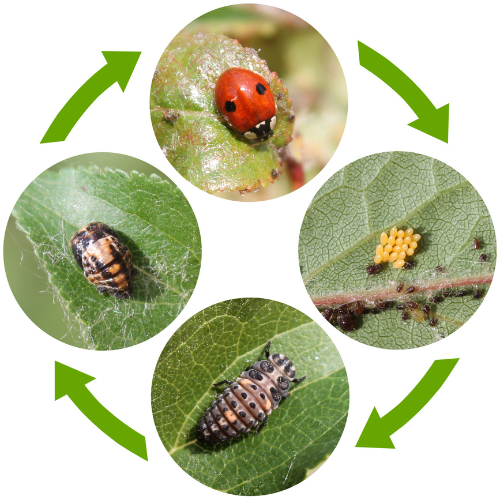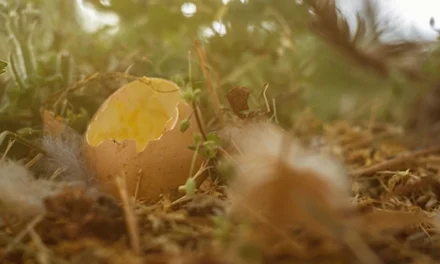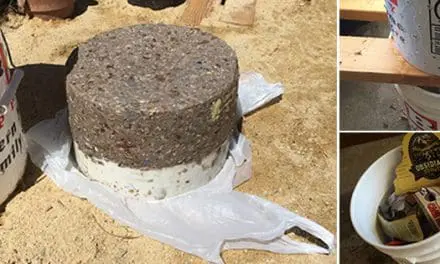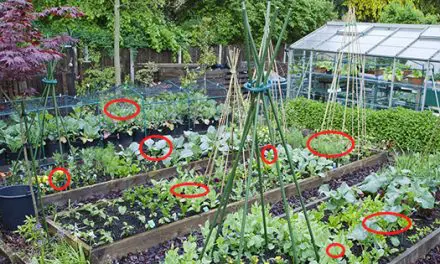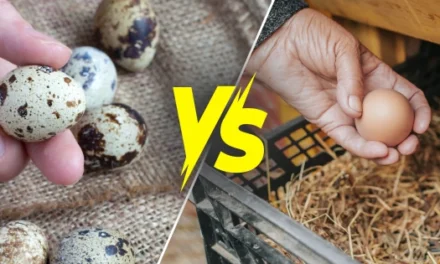Tired of watching your plants get chewed up by aphids, and not keen on dousing your garden in chemicals? There’s a natural solution hiding in plain sight… and it has a serious appetite for garden pests.
These tiny warriors don’t just handle aphids. They go after mites, scale insects, and more, making them some of the best allies a gardener could ask for.
And here’s the real magic. Inviting them in does more than just fix your pest problems. It helps create a thriving, balanced ecosystem right in your backyard. And you’d be surprised just how easy it is to get them to show up.
Why Are Ladybugs Good For The Garden?
Natural pest control.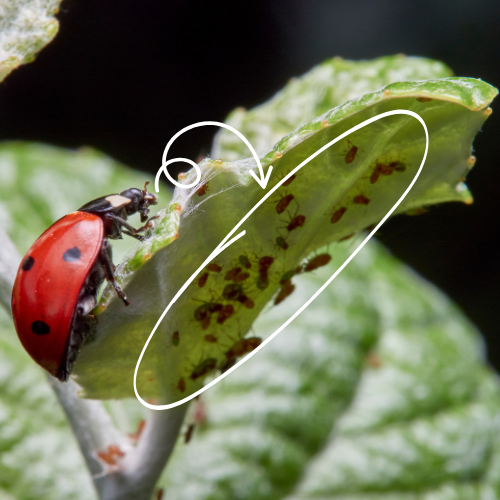
Ladybugs are a valuable addition to your garden, one that many homesteaders completely forget about. It would be a shame to make this mistake since attracting ladybugs offers some very important advantages:
- Effective Pest Control: Ladybugs are incredibly efficient predators. A single ladybug can eat hundreds of aphids in its lifetime.
- Chemical-Free Solution: Attracting ladybugs is a natural way to control pests without using harmful pesticides.
- Beneficial for the Environment: By reducing the need for pesticides, you’re helping to protect the environment and the health of other beneficial insects.
- A Sign of a Healthy Garden: A garden that attracts ladybugs is a garden that’s full of life and variety.
Creating a Ladybug-Friendly Habitat
The key to attracting ladybugs is to create a habitat that meets their needs. This means providing them with food, water, shelter, and a safe place to lay their eggs. Here’s how to do it:
Plant the Right Plants
Ladybugs are attracted to certain plants that provide them with food and shelter. Here are some of the best plants for attracting ladybugs:
- Flowers:
- Yarrow: Yarrow is a hardy perennial with clusters of small, daisy-like flowers that attract ladybugs and other beneficial insects.

- Daisies: Daisies are classic garden flowers that provide nectar and pollen for ladybugs.
- Marigolds: Marigolds are known for their pest-repelling properties, but they also attract ladybugs.
- Calendula: Calendula is a medicinal herb with bright orange flowers that attract ladybugs and other pollinators.
- Dill: Dill is a flavorful herb that attracts ladybugs and other beneficial insects.
- Fennel: Fennel is another herb that attracts ladybugs and provides them with food and shelter.
- Cilantro: Cilantro is a popular herb that attracts ladybugs and other beneficial insects.
- Queen Anne’s Lace: This wildflower is known for its umbrella-shaped clusters of white flowers that attract ladybugs.
- Yarrow: Yarrow is a hardy perennial with clusters of small, daisy-like flowers that attract ladybugs and other beneficial insects.
- Other Plants:
- Cover Crops: Cover crops like clover and alfalfa provide ladybugs with food and shelter, especially during the winter months.
- Grasses: Leaving some patches of grass uncut can provide ladybugs with overwintering habitat.
- Native Plants: Native plants are always a good choice for attracting beneficial insects, as they’re adapted to your local climate and provide the best habitat for native species.
🌿When you plant yarrow or calendula, you’re essentially rolling out the welcome mat for these little predators, who will gladly help you manage aphids, mites, and other pesky invaders that threaten your plants.
If you don’t yet have at least some of these plants in your garden, I strongly recommend you take advantage of this month’s temperatures and start planting right now. You can actually get the seeds for many of these ladybug-loving flowers, along with many other beneficial plants, from Nicole Apelian’s Medicinal Garden Kit. It includes seeds like calendula, yarrow, chamomile, and many more that ladybugs and other garden-heroes simply can’t resist.
🐝This kit is designed to help you build a thriving garden ecosystem. Other plants included in it, like echinacea, california poppy, lavender or chicory help to repel pests, and bring in the bees and butterflies that are crucial for pollinating your veggies and flowers. Long story short, while ladybugs stay busy eating aphids, other insects, like bees, butterflies, and beetles are out there pollinating, helping your crops grow strong and healthy.
🪻What’s more, the NON-GMO plants in this kit aren’t just pest fighters. They also have incredible medicinal properties that can be used in your kitchen or for countless remedies. Chamomile is perfect for soothing teas, while calendula is known for its skin-healing properties. Echinacea is widely used to support immune health, and lavender can be used in everything from calming oils to baking. So not only will you have a garden that attracts ladybugs and other helpful insects, but you’ll also have a ready supply of natural remedies and culinary herbs right at your fingertips!
🏵️So, why wait? Start planting now, and let your garden’s natural helpers get to work.
Provide a Water Source
Ladybugs need water to survive, especially during hot, dry weather. Here are some ways to provide them with a water source:
- Bird Bath: A shallow bird bath with clean water is a great way to provide ladybugs with a drink.
- Shallow Dish: Fill a shallow dish with water and add some pebbles or marbles for the ladybugs to land on.
- Spray Bottle: Mist your plants with water regularly, especially during dry spells.
Offer Shelter
Ladybugs need shelter from the elements, especially during the winter months. Here are some ways to provide them with shelter:
- Leave Leaf Litter: Don’t be too quick to clean up your garden in the fall. Leaving some leaf litter provides ladybugs with a place to overwinter.
- Rock Piles: A pile of rocks can provide ladybugs with a cool, shady spot to escape the heat.
- Brush Piles: A brush pile can provide ladybugs with shelter from the wind and rain.
- Ladybug Houses: You can buy or build ladybug houses to provide them with a safe place to overwinter.
Avoid Pesticides
Pesticides are harmful to ladybugs and other beneficial insects. Avoid using pesticides in your garden, or use them sparingly and only when necessary. If you must use pesticides, choose homemade weed killer options that are less harmful to beneficial insects.
🌿If You See This Plant In Your Backyard, Don’t Step On It!🌿
Tolerate a Few Pests
It might sound counterintuitive, but to attract ladybugs, you need to tolerate a few pests in your garden. Ladybugs need something to eat, so if you eliminate all of their food sources, they’ll move on to another garden.
Consider Buying Ladybugs (With Caution)
You can purchase ladybugs online or at your local garden center. However, it’s important to be aware that many commercially raised ladybugs are collected from the wild and may not be adapted to your local climate. They may also fly away soon after you release them.
If you do decide to buy ladybugs, choose a reputable supplier and release them in your garden in the evening, when they’re less likely to fly away. Mist your plants with water before releasing the ladybugs to provide them with a drink.
Recognizing Ladybug Larvae
Don’t be fooled by their appearance – ladybug larvae are just as effective at controlling pests as adult ladybugs. Ladybug larvae look like tiny, alligator-like creatures with black and orange markings. They’re often found on plants that are infested with aphids.
If you see ladybug larvae in your garden, resist the urge to spray them with pesticides. They’re your allies in the fight against pests.
More Than Just Ladybugs
Attracting ladybugs is just one piece of the puzzle when it comes to creating a healthy, balanced garden. Here are some other things you can do to promote biodiversity and attract other beneficial insects:
- Plant a Variety of Plants: A diverse garden is a healthy garden. Plant a variety of flowers, herbs, vegetables, and trees to provide food and shelter for a wide range of beneficial insects.
- Provide a Pollinator Habitat: Attract pollinators like bees, butterflies, and hummingbirds by planting flowers that provide nectar and pollen.
- Build a Bug Hotel: A bug hotel is a structure that provides shelter for a variety of beneficial insects.
- Practice Companion Planting: Companion planting involves planting certain plants together to benefit each other. For example, planting basil near tomatoes can help to repel pests.
Companion planting is more than just an effective way to reduce pests. It’s also a strategy that can help you grow more with less. When you plant compatible crops together, you create a garden that works in harmony, where plants support each other’s growth.
👨🌾The Amish have mastered this approach, using companion planting to grow large amounts of food on relatively small plots of land. One of their most famous combinations is the “Three Sisters”: corn, beans, and squash. This trio benefits each other in multiple ways. Corn provides a natural trellis for the beans, beans enrich the soil with nitrogen, and squash covers the ground, blocking weeds and retaining moisture.
🌾By using similar techniques, you can double your yield without expanding your garden space. You can learn how to grow twice as much food on the same piece of land by mastering the art of companion planting and other smart strategies that help your plants thrive. And you can do so directly from Eddie Swartzentruber, an ex-Amish member, who knows firsthand how to make the most of every single inch of land. Find out everything he has to say here.
The Rewards of Your Ladybug-Friendly Garden
Attracting ladybugs to your garden is a rewarding way to control pests naturally, promote biodiversity, and create a healthy, balanced ecosystem. By providing ladybugs with food, water, shelter, and a safe place to lay their eggs, you can transform your garden into a haven for these tiny warriors. So, ditch the pesticides and embrace the power of ladybugs!
Turmeric for Plants? Sprinkle It in Your Garden and Watch What Happens!
How To Build Self-Watering Raised Garden Beds (Video)
7 Creepy Crawlers You Should Welcome In Your Garden
Three Sisters Planting – How to Plant The Three Sisters Garden

